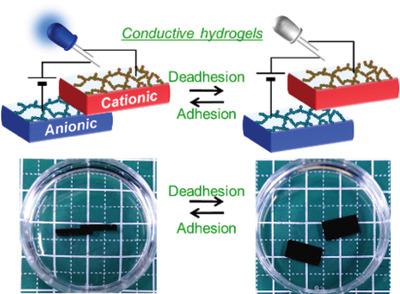当前位置:
X-MOL 学术
›
Macromol. Rapid Commun.
›
论文详情
Our official English website, www.x-mol.net, welcomes your
feedback! (Note: you will need to create a separate account there.)
Electrophoretic Adhesion of Conductive Hydrogels.
Macromolecular Rapid Communications ( IF 4.2 ) Pub Date : 2020-05-13 , DOI: 10.1002/marc.202000169 Taka-Aki Asoh 1 , Megumi Nakamura 1, 2 , Tatsuya Shoji 2 , Yasuyuki Tsuboi 2 , Hiroshi Uyama 1
Macromolecular Rapid Communications ( IF 4.2 ) Pub Date : 2020-05-13 , DOI: 10.1002/marc.202000169 Taka-Aki Asoh 1 , Megumi Nakamura 1, 2 , Tatsuya Shoji 2 , Yasuyuki Tsuboi 2 , Hiroshi Uyama 1
Affiliation

|
For the development of next‐generation wearable and implantable devices that connect the human body and machines, the adhesion of a conductive hydrogel is required. In this study, a conductive hydrogel is adhered using an electrophoretic approach through polyion complex formation at the interface of the hydrogels. Cationic and anionic conductive hydrogels adhere to anionic and cationic hydrogels, respectively. Moreover, the cationic and anionic conductive hydrogels adhere strongly to each other and the adhered conductive hydrogels exhibit conductivity. De‐adhesion is possible by adding a salt and re‐adhesion is demonstrated under aqueous conditions. It is believed that this innovative adhesion strategy for conductive hydrogels will be a fundamental technology for the connecting “soft” people and “hard” machines.
中文翻译:

导电水凝胶的电泳粘合。
为了开发连接人体和机器的下一代可穿戴和可植入设备,需要导电水凝胶的粘附力。在这项研究中,导电的水凝胶通过电泳方法通过在水凝胶界面形成聚离子复合物而粘附。阳离子和阴离子导电水凝胶分别粘附于阴离子和阳离子水凝胶。而且,阳离子和阴离子导电水凝胶彼此牢固地粘附,并且粘附的导电水凝胶显示出导电性。可以通过添加盐来实现去粘连,并在水性条件下证明了重新粘连。可以相信,这种创新的导电水凝胶粘合策略将是连接“软”人和“硬”机器的一项基本技术。
更新日期:2020-06-18
中文翻译:

导电水凝胶的电泳粘合。
为了开发连接人体和机器的下一代可穿戴和可植入设备,需要导电水凝胶的粘附力。在这项研究中,导电的水凝胶通过电泳方法通过在水凝胶界面形成聚离子复合物而粘附。阳离子和阴离子导电水凝胶分别粘附于阴离子和阳离子水凝胶。而且,阳离子和阴离子导电水凝胶彼此牢固地粘附,并且粘附的导电水凝胶显示出导电性。可以通过添加盐来实现去粘连,并在水性条件下证明了重新粘连。可以相信,这种创新的导电水凝胶粘合策略将是连接“软”人和“硬”机器的一项基本技术。









































 京公网安备 11010802027423号
京公网安备 11010802027423号